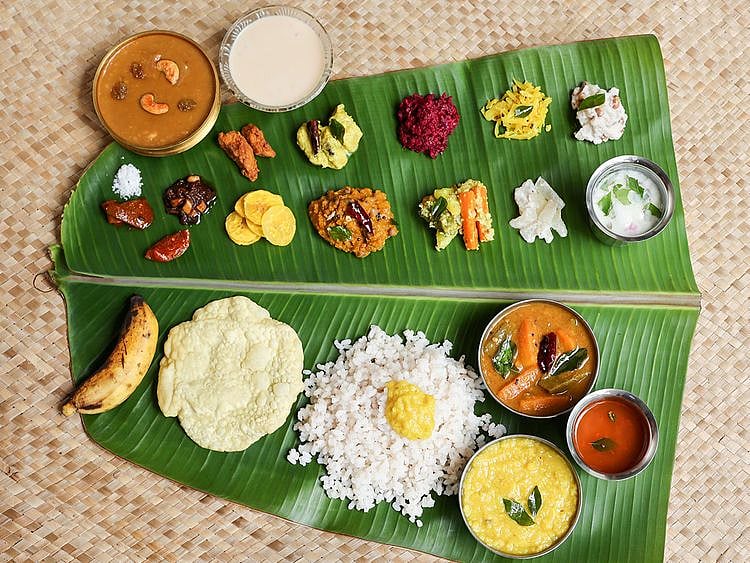Celebrating Onam: Everything you need to know about Onam Sadya
Here are 21 simple recipes that you can try out for Onam Sadya

This time of the month is very special to Indian expatriates, especially from Kerala. Why? It’s Onam – an annual harvest festival.
For Keralites, it is not just a celebration but a time for nostalgia, family, and tradition that helps bridge the gap between their today and their memories. It reminds them of the ties that anchor them to their roots - they find joy in shared customs and strengthen their connections, even across continents.
The significance of Onam
Onam is an annual harvest festival that marks the homecoming of the mythical king Mahabali. As per legend, demon king Mahabali was a generous and virtuous ruler who was loved by his subjects. Worried by his growing popularity despite being a demon, detractors took the help of the deity Vishnu. He took on the form of Vamana, an alms-seeking mendicant, and went to Mahabali. The generous king ended up giving away his kingdom and place on Earth, while being pushed into the netherworld. However, due to his good nature, Mahabali was granted the boon to visit his people once a year, which is celebrated as Onam. The festival signifies the return of prosperity and happiness, with the belief that Mahabali visits his kingdom during this time.
Celebrations and traditions
Onam is a festival that lasts for ten days, starting with 'Atham' or the first day and ending with 'Thiruvonam'. The festivities include many traditional activities, such as creating beautiful floral patterns called 'Pookkalam', cultural performances, traditional music known as 'Onapattu', and a grand feast called 'Ona or Onam Sadya.'
The sadya or festive meal is served on banana leaves. It showcases the diverse flavours of the region with vegetarian dishes made from locally grown ingredients. It's a gastronomical journey that celebrates community and tradition. Savoured slowly, the it is an experience not to be missed.
Let's find out how a sadya should be eaten and explore the reasons behind its unique dining experience, but first, take a look at these easy Onam recipes.
21 recipes for Onam
If you are looking to prepare some delicious dishes for the upcoming Onam festival, we've got you covered with these simple and easy-to-follow recipes. Make this Onam a truly memorable and delicious one!
The arrangement of dishes
The meal is a visual and culinary spectacle with a carefully curated arrangement of dishes. The feast usually starts with crisp banana chips, pappadam (papad), and tangy mango pickle to awaken the palate. The meal progresses to curries and accompaniments placed on the banana leaf, each serving representing a unique flavour profile and culinary technique. The highlight is the exquisite array of dishes, including warm fragrant rice, sambar, rasam, avial, olan, thoran, kootu curry, and more. The grand finale different types of payasams, or sweet puddings, that round off the feast on a sweet note.
Eating etiquette: A sensory experience
The art of eating a sadya is as important as the dishes themselves. The banana leaf, meticulously cleaned and positioned, serves as the plate. Washing the leaf gently before starting the meal is important, signifying respect for the food and the tradition. The meal is eaten using the fingers of the right hand, as per Indian custom.
The banana leaf serves a purpose beyond being a serving platter. Folding the leaf towards you indicates that you enjoyed the meal while folding it away means you didn't find the meal satisfactory.
Why eat with your hands?
Eating a sadya with your hands isn't just a matter of tradition; it's rooted in Ayurvedic philosophy and practicality. The fingertips are sensitive because of nerve endings, and eating with your hands allows you to feel the textures of the food, enhancing the sensory experience. Moreover, the natural oils on the fingers are believed to aid digestion and even influence the flavours. This tactile connection between the diner and the food adds a personal touch to the dining experience.
The order of enjoyment
Sadya is meant to be enjoyed in a specific order. A small amount of salt is placed on the top corner of the banana leaf. Eating a bit of salt is believed to cleanse the palate and stimulate the appetite. Then, start with the rice, which forms the base of the meal. Then, move on to the various curries and accompaniments, savouring each flavour without overwhelming the palate. Combining different flavours and textures is an art, and it's best to explore each dish individually before creating your harmonious combinations.
Sadya transcends culinary indulgence; it's a symbol of unity and togetherness. In Kerala, a sadya is often served during festivals, weddings, and other special occasions, and it encourages people to sit together, share food, and forge connections. The communal nature of the meal reflects the essence of Kerala's hospitality and inclusive culture.
Sadya: A celebration of tradition
Sadya is more than just a meal; it's a sensory celebration of tradition, community, and the culinary treasures of Kerala. The art of eating this elaborate meal is a harmonious blend of flavours, textures, and cultural practices, and it offers a unique way to connect with the region's rich heritage. So, the next time you sit down to enjoy a sadya, remember that you're not just consuming a meal but participating in an age-old tradition that's steeped in history and flavour.
In today's fast-paced world, Onam serves as a reminder of the importance of connecting with one's roots. While modern celebrations may incorporate new elements, the essence of Onam remains unchanged - a time for family reunions and an extravagant feast that transcends culinary boundaries.
Sign up for the Daily Briefing
Get the latest news and updates straight to your inbox
Network Links
GN StoreDownload our app
© Al Nisr Publishing LLC 2025. All rights reserved.